Daojing He
Neural Parameter Search for Slimmer Fine-Tuned Models and Better Transfer
May 24, 2025Abstract:Foundation models and their checkpoints have significantly advanced deep learning, boosting performance across various applications. However, fine-tuned models often struggle outside their specific domains and exhibit considerable redundancy. Recent studies suggest that combining a pruned fine-tuned model with the original pre-trained model can mitigate forgetting, reduce interference when merging model parameters across tasks, and improve compression efficiency. In this context, developing an effective pruning strategy for fine-tuned models is crucial. Leveraging the advantages of the task vector mechanism, we preprocess fine-tuned models by calculating the differences between them and the original model. Recognizing that different task vector subspaces contribute variably to model performance, we introduce a novel method called Neural Parameter Search (NPS-Pruning) for slimming down fine-tuned models. This method enhances pruning efficiency by searching through neural parameters of task vectors within low-rank subspaces. Our method has three key applications: enhancing knowledge transfer through pairwise model interpolation, facilitating effective knowledge fusion via model merging, and enabling the deployment of compressed models that retain near-original performance while significantly reducing storage costs. Extensive experiments across vision, NLP, and multi-modal benchmarks demonstrate the effectiveness and robustness of our approach, resulting in substantial performance gains. The code is publicly available at: https://github.com/duguodong7/NPS-Pruning.
One Model Transfer to All: On Robust Jailbreak Prompts Generation against LLMs
May 23, 2025Abstract:Safety alignment in large language models (LLMs) is increasingly compromised by jailbreak attacks, which can manipulate these models to generate harmful or unintended content. Investigating these attacks is crucial for uncovering model vulnerabilities. However, many existing jailbreak strategies fail to keep pace with the rapid development of defense mechanisms, such as defensive suffixes, rendering them ineffective against defended models. To tackle this issue, we introduce a novel attack method called ArrAttack, specifically designed to target defended LLMs. ArrAttack automatically generates robust jailbreak prompts capable of bypassing various defense measures. This capability is supported by a universal robustness judgment model that, once trained, can perform robustness evaluation for any target model with a wide variety of defenses. By leveraging this model, we can rapidly develop a robust jailbreak prompt generator that efficiently converts malicious input prompts into effective attacks. Extensive evaluations reveal that ArrAttack significantly outperforms existing attack strategies, demonstrating strong transferability across both white-box and black-box models, including GPT-4 and Claude-3. Our work bridges the gap between jailbreak attacks and defenses, providing a fresh perspective on generating robust jailbreak prompts. We make the codebase available at https://github.com/LLBao/ArrAttack.
MTSA: Multi-turn Safety Alignment for LLMs through Multi-round Red-teaming
May 22, 2025Abstract:The proliferation of jailbreak attacks against large language models (LLMs) highlights the need for robust security measures. However, in multi-round dialogues, malicious intentions may be hidden in interactions, leading LLMs to be more prone to produce harmful responses. In this paper, we propose the \textbf{M}ulti-\textbf{T}urn \textbf{S}afety \textbf{A}lignment (\ourapproach) framework, to address the challenge of securing LLMs in multi-round interactions. It consists of two stages: In the thought-guided attack learning stage, the red-team model learns about thought-guided multi-round jailbreak attacks to generate adversarial prompts. In the adversarial iterative optimization stage, the red-team model and the target model continuously improve their respective capabilities in interaction. Furthermore, we introduce a multi-turn reinforcement learning algorithm based on future rewards to enhance the robustness of safety alignment. Experimental results show that the red-team model exhibits state-of-the-art attack capabilities, while the target model significantly improves its performance on safety benchmarks.
Multi-Modality Expansion and Retention for LLMs through Parameter Merging and Decoupling
May 21, 2025Abstract:Fine-tuning Large Language Models (LLMs) with multimodal encoders on modality-specific data expands the modalities that LLMs can handle, leading to the formation of Multimodal LLMs (MLLMs). However, this paradigm heavily relies on resource-intensive and inflexible fine-tuning from scratch with new multimodal data. In this paper, we propose MMER (Multi-modality Expansion and Retention), a training-free approach that integrates existing MLLMs for effective multimodal expansion while retaining their original performance. Specifically, MMER reuses MLLMs' multimodal encoders while merging their LLM parameters. By comparing original and merged LLM parameters, MMER generates binary masks to approximately separate LLM parameters for each modality. These decoupled parameters can independently process modality-specific inputs, reducing parameter conflicts and preserving original MLLMs' fidelity. MMER can also mitigate catastrophic forgetting by applying a similar process to MLLMs fine-tuned on new tasks. Extensive experiments show significant improvements over baselines, proving that MMER effectively expands LLMs' multimodal capabilities while retaining 99% of the original performance, and also markedly mitigates catastrophic forgetting.
ProjectEval: A Benchmark for Programming Agents Automated Evaluation on Project-Level Code Generation
Mar 10, 2025



Abstract:Recently, LLM agents have made rapid progress in improving their programming capabilities. However, existing benchmarks lack the ability to automatically evaluate from users' perspective, and also lack the explainability of the results of LLM agents' code generation capabilities. Thus, we introduce ProjectEval, a new benchmark for LLM agents project-level code generation's automated evaluation by simulating user interaction. ProjectEval is constructed by LLM with human reviewing. It has three different level inputs of natural languages or code skeletons. ProjectEval can evaluate the generated projects by user interaction simulation for execution, and by code similarity through existing objective indicators. Through ProjectEval, we find that systematic engineering project code, overall understanding of the project and comprehensive analysis capability are the keys for LLM agents to achieve practical projects. Our findings and benchmark provide valuable insights for developing more effective programming agents that can be deployed in future real-world production.
Knowledge Editing with Dynamic Knowledge Graphs for Multi-hop Question Answering
Dec 18, 2024



Abstract:Multi-hop question answering (MHQA) poses a significant challenge for large language models (LLMs) due to the extensive knowledge demands involved. Knowledge editing, which aims to precisely modify the LLMs to incorporate specific knowledge without negatively impacting other unrelated knowledge, offers a potential solution for addressing MHQA challenges with LLMs. However, current solutions struggle to effectively resolve issues of knowledge conflicts. Most parameter-preserving editing methods are hindered by inaccurate retrieval and overlook secondary editing issues, which can introduce noise into the reasoning process of LLMs. In this paper, we introduce KEDKG, a novel knowledge editing method that leverages a dynamic knowledge graph for MHQA, designed to ensure the reliability of answers. KEDKG involves two primary steps: dynamic knowledge graph construction and knowledge graph augmented generation. Initially, KEDKG autonomously constructs a dynamic knowledge graph to store revised information while resolving potential knowledge conflicts. Subsequently, it employs a fine-grained retrieval strategy coupled with an entity and relation detector to enhance the accuracy of graph retrieval for LLM generation. Experimental results on benchmarks show that KEDKG surpasses previous state-of-the-art models, delivering more accurate and reliable answers in environments with dynamic information.
Toward Robust and Accurate Adversarial Camouflage Generation against Vehicle Detectors
Nov 15, 2024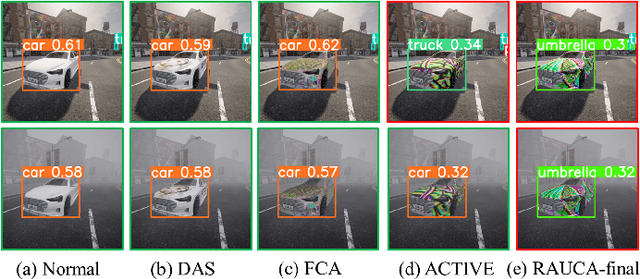
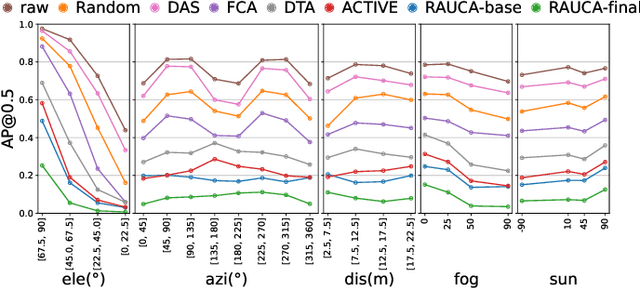

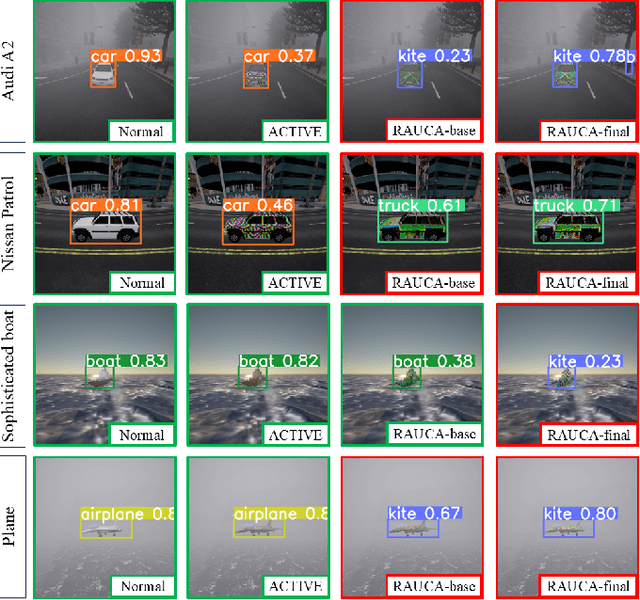
Abstract:Adversarial camouflage is a widely used physical attack against vehicle detectors for its superiority in multi-view attack performance. One promising approach involves using differentiable neural renderers to facilitate adversarial camouflage optimization through gradient back-propagation. However, existing methods often struggle to capture environmental characteristics during the rendering process or produce adversarial textures that can precisely map to the target vehicle. Moreover, these approaches neglect diverse weather conditions, reducing the efficacy of generated camouflage across varying weather scenarios. To tackle these challenges, we propose a robust and accurate camouflage generation method, namely RAUCA. The core of RAUCA is a novel neural rendering component, End-to-End Neural Renderer Plus (E2E-NRP), which can accurately optimize and project vehicle textures and render images with environmental characteristics such as lighting and weather. In addition, we integrate a multi-weather dataset for camouflage generation, leveraging the E2E-NRP to enhance the attack robustness. Experimental results on six popular object detectors show that RAUCA-final outperforms existing methods in both simulation and real-world settings.
Parameter Competition Balancing for Model Merging
Oct 03, 2024
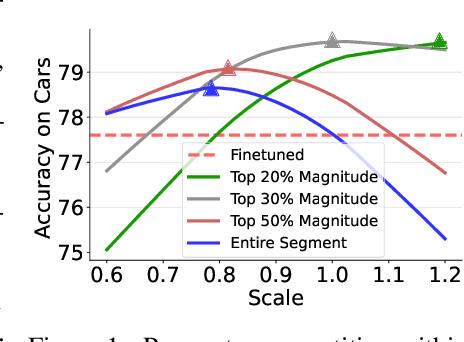
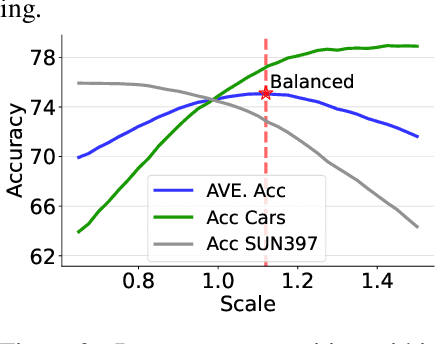
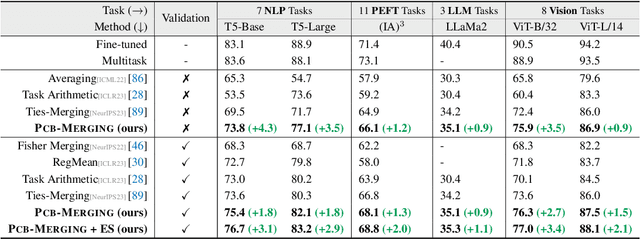
Abstract:While fine-tuning pretrained models has become common practice, these models often underperform outside their specific domains. Recently developed model merging techniques enable the direct integration of multiple models, each fine-tuned for distinct tasks, into a single model. This strategy promotes multitasking capabilities without requiring retraining on the original datasets. However, existing methods fall short in addressing potential conflicts and complex correlations between tasks, especially in parameter-level adjustments, posing a challenge in effectively balancing parameter competition across various tasks. This paper introduces an innovative technique named PCB-Merging (Parameter Competition Balancing), a lightweight and training-free technique that adjusts the coefficients of each parameter for effective model merging. PCB-Merging employs intra-balancing to gauge parameter significance within individual tasks and inter-balancing to assess parameter similarities across different tasks. Parameters with low importance scores are dropped, and the remaining ones are rescaled to form the final merged model. We assessed our approach in diverse merging scenarios, including cross-task, cross-domain, and cross-training configurations, as well as out-of-domain generalization. The experimental results reveal that our approach achieves substantial performance enhancements across multiple modalities, domains, model sizes, number of tasks, fine-tuning forms, and large language models, outperforming existing model merging methods. The code is publicly available at: \url{https://github.com/duguodong7/pcb-merging}.
CNCA: Toward Customizable and Natural Generation of Adversarial Camouflage for Vehicle Detectors
Sep 26, 2024



Abstract:Prior works on physical adversarial camouflage against vehicle detectors mainly focus on the effectiveness and robustness of the attack. The current most successful methods optimize 3D vehicle texture at a pixel level. However, this results in conspicuous and attention-grabbing patterns in the generated camouflage, which humans can easily identify. To address this issue, we propose a Customizable and Natural Camouflage Attack (CNCA) method by leveraging an off-the-shelf pre-trained diffusion model. By sampling the optimal texture image from the diffusion model with a user-specific text prompt, our method can generate natural and customizable adversarial camouflage while maintaining high attack performance. With extensive experiments on the digital and physical worlds and user studies, the results demonstrate that our proposed method can generate significantly more natural-looking camouflage than the state-of-the-art baselines while achieving competitive attack performance. Our code is available at \href{https://anonymous.4open.science/r/CNCA-1D54}{https://anonymous.4open.science/r/CNCA-1D54}
RAUCA: A Novel Physical Adversarial Attack on Vehicle Detectors via Robust and Accurate Camouflage Generation
Feb 24, 2024



Abstract:Adversarial camouflage is a widely used physical attack against vehicle detectors for its superiority in multi-view attack performance. One promising approach involves using differentiable neural renderers to facilitate adversarial camouflage optimization through gradient back-propagation. However, existing methods often struggle to capture environmental characteristics during the rendering process or produce adversarial textures that can precisely map to the target vehicle, resulting in suboptimal attack performance. Moreover, these approaches neglect diverse weather conditions, reducing the efficacy of generated camouflage across varying weather scenarios. To tackle these challenges, we propose a robust and accurate camouflage generation method, namely RAUCA. The core of RAUCA is a novel neural rendering component, Neural Renderer Plus (NRP), which can accurately project vehicle textures and render images with environmental characteristics such as lighting and weather. In addition, we integrate a multi-weather dataset for camouflage generation, leveraging the NRP to enhance the attack robustness. Experimental results on six popular object detectors show that RAUCA consistently outperforms existing methods in both simulation and real-world settings.
 Add to Chrome
Add to Chrome Add to Firefox
Add to Firefox Add to Edge
Add to Edge